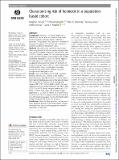Characterising risk of homicide in a population-based cohort
Abstract
Background: Homicide is an extreme expression of violence that has attracted less attention from public health researchers and policy makers interested in prevention. The purpose of this study was to examine the socioeconomic gradient of homicide and to determine whether risk differs by immigration status. Methods: We conducted a population-based cohort study using linked vital statistics, census and population data sets that included all deaths by homicide from 1992 to 2012 in Ontario, Canada. We calculated age-adjusted death rates for homicide by material deprivation quintiles, stratified by immigration status. Count-based negative binomial regression models were used to calculate unadjusted and adjusted rate ratios with predictors of interest being age, urban residence, material deprivation and immigration status. A subanalysis containing immigrants only examined the effect of time since immigration and immigration class. Results: There were 3345 homicide deaths registered between 1992 and 2012. Relative to low material deprivation areas, age-adjusted rates of homicide deaths in high materially deprived areas were similar among refugees (RR: 48.49; 95% CI 36.99 to 62.45) and long-term residents (RR: 47.67; 95% CI 44.66 to 50.83), but were slightly lower for non-refugee immigrants (RR: 38.53; 95% CI 32.42 to 45.45). Female refugees experienced a 1.31 (95% CI 0.88 to 1.94) higher rate and male refugees experienced a 1.23 (95% CI 0.90 to 1.67) higher rate of homicide victimisation compared with long-term residents. In an immigrant only analysis, the risk of homicide among refugees increased with duration of residence. Conclusions: Given the large area-level, socioeconomic status gradients observed in homicides among refugees, community-level and culturally appropriate prevention approaches are important.
Citation
O'Neill , M , Buajitti , E , Donnelly , P D , Lewis , J , Kornas , K & Rosella , L C 2020 , ' Characterising risk of homicide in a population-based cohort ' , Journal of Epidemiology and Community Health , vol. 74 , no. 12 , pp. 1028-1034 . https://doi.org/10.1136/jech-2019-213249
Publication
Journal of Epidemiology and Community Health
Status
Peer reviewed
ISSN
0143-005XType
Journal article
Description
Funding: This study was supported by ICES, which is funded by anannual grant from the Ontario Ministry of Health and Long-Term Care (MOHLTC).Collections
Items in the St Andrews Research Repository are protected by copyright, with all rights reserved, unless otherwise indicated.

